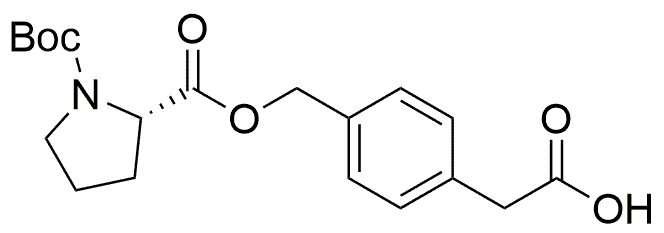Boc-L-Pro-O-CH2-Ph-CH2-COOH is widely utilized in research focused on:
- Peptide Synthesis: This compound serves as a protecting group in the synthesis of peptides, allowing chemists to selectively modify amino acids without affecting others. This is crucial for creating complex peptides used in pharmaceuticals.
- Drug Development: Its structural properties make it valuable in the design of new drugs, particularly in developing compounds that target specific biological pathways, enhancing efficacy and reducing side effects.
- Bioconjugation: The compound can be used to create bioconjugates, which are essential in developing targeted therapies and diagnostics in the biomedical field, improving the precision of treatments.
- Research in Neuroscience: It plays a role in studies related to neurotransmitter pathways, helping researchers understand brain functions and develop potential treatments for neurological disorders.
- Cosmetic Formulations: Due to its stability and compatibility with various ingredients, it can be incorporated into cosmetic products, enhancing skin absorption and effectiveness of active ingredients.
General Information
Properties
Safety and Regulations
Applications
Boc-L-Pro-O-CH2-Ph-CH2-COOH is widely utilized in research focused on:
- Peptide Synthesis: This compound serves as a protecting group in the synthesis of peptides, allowing chemists to selectively modify amino acids without affecting others. This is crucial for creating complex peptides used in pharmaceuticals.
- Drug Development: Its structural properties make it valuable in the design of new drugs, particularly in developing compounds that target specific biological pathways, enhancing efficacy and reducing side effects.
- Bioconjugation: The compound can be used to create bioconjugates, which are essential in developing targeted therapies and diagnostics in the biomedical field, improving the precision of treatments.
- Research in Neuroscience: It plays a role in studies related to neurotransmitter pathways, helping researchers understand brain functions and develop potential treatments for neurological disorders.
- Cosmetic Formulations: Due to its stability and compatibility with various ingredients, it can be incorporated into cosmetic products, enhancing skin absorption and effectiveness of active ingredients.
Documents
Safety Data Sheets (SDS)
The SDS provides comprehensive safety information on handling, storage, and disposal of the product.
Product Specification (PS)
The PS provides a comprehensive breakdown of the product’s properties, including chemical composition, physical state, purity, and storage requirements. It also details acceptable quality ranges and the product's intended applications.
Certificates of Analysis (COA)
Search for Certificates of Analysis (COA) by entering the products Lot Number. Lot and Batch Numbers can be found on a product’s label following the words ‘Lot’ or ‘Batch’.
*Catalog Number
*Lot Number
Certificates Of Origin (COO)
This COO confirms the country where the product was manufactured, and also details the materials and components used in it and whether it is derived from natural, synthetic, or other specific sources. This certificate may be required for customs, trade, and regulatory compliance.
*Catalog Number
*Lot Number
Safety Data Sheets (SDS)
The SDS provides comprehensive safety information on handling, storage, and disposal of the product.
DownloadProduct Specification (PS)
The PS provides a comprehensive breakdown of the product’s properties, including chemical composition, physical state, purity, and storage requirements. It also details acceptable quality ranges and the product's intended applications.
DownloadCertificates of Analysis (COA)
Search for Certificates of Analysis (COA) by entering the products Lot Number. Lot and Batch Numbers can be found on a product’s label following the words ‘Lot’ or ‘Batch’.
*Catalog Number
*Lot Number
Certificates Of Origin (COO)
This COO confirms the country where the product was manufactured, and also details the materials and components used in it and whether it is derived from natural, synthetic, or other specific sources. This certificate may be required for customs, trade, and regulatory compliance.

